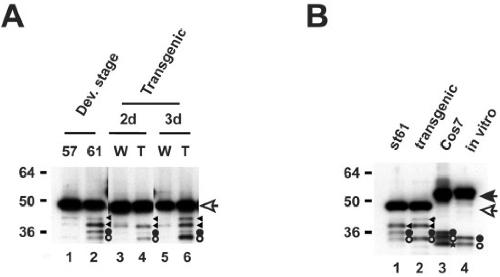XB-IMG-83825
Xenbase Image ID: 83825

|
|
Fig. 6. ST3 degrades LR in vivo. A: LR is degraded in the intestine at the climax of metamorphosis
and in the intestine of premetamorphic transgenic tadpoles overexpressing ST3. Transgenic F1
animals (T) and non-transgenic siblings (W) were heat shocked daily in a same tank. Two (2d) or
three days (3d) later, the intestines were isolated. Total protein was isolated from these intestines
as well as from the intestines of premetamorphic tadpoles at stage 57 (57) or metamorphosing
tadpoles at stage 61 (61). The proteins were subjected to Western blotting with anti-Xenopus LR
antibody. The open arrow indicates full-length LR. The triangles, and solid and open circles indicate
degradation products. The larger bands (triangles) were occasionally observed in different sample
preparations in tadpoles at different stages but the bands indicated by the circles were found only
in metamorphosing intestine or in animals expressing transgenic ST3. B: The LR degradation
profile in tadpoles suggests that LR is cleaved by ST3. Protein samples from intestine of stage 61
(st61, lane 1) and transgenic (lane 2) tadpoles, conditioned medium of Cos7 cells cultured in the
presence of added ST3Cw (see Fig. 5) (lane 3), and purified LR treated with ST3Cw (Amano et al.,
2005) (lane 4) were subjected to Western blotting with anti-LR antibody. Solid and open arrows
indicate full-length LR with or without the tag, respectively. Open and closed circles point to
degradation products. The larger degradation products (triangles) are likely non-specific (see A).
The star indicates a non-specific background band (see Fig. 5). Note that in vivo products are larger
than in vitro products, likely due to the in vivo modifications. The degradation fragments of
overexpressed LR in Cos7 cells are of similar sizes as those in tadpoles. Image published in: Amano T et al. (2005) Copyright © 2005. Image reproduced with permission of the Publisher, John Wiley & Sons. Larger Image Printer Friendly View |
